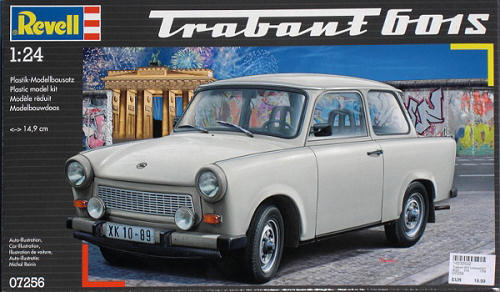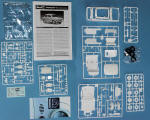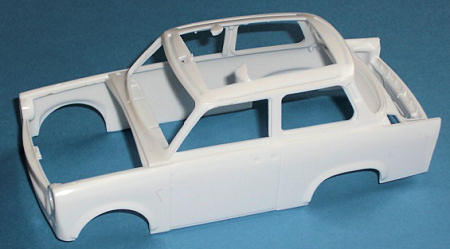
Revell 1/24 Trabant 601 S
| KIT #: | 07256 |
| PRICE: | 20 € (~30 $ in Dec 2009) |
| DECALS: | License plates for 7 cars from 5 countries |
| REVIEWER: | Martin Sczepan |
| NOTES: | New mold kit, not related to 1990 kit of the same car |

| HISTORY |
Let us begin this in-box review with some
questions:
Which car was the first to use a body made from
recycled material?
Which car was so sought after that you had to
wait ten years to get one?
Which car became a symbol first for the
standing still in the country it produced and later for the reunification of a
divided country?
And at last: Which car is the quietest on
earth?
You guess it. After all this is an in-box
review of the Revell Germany Trabant 601 kit. For the last question there is an
explanation: If you are squeezed inside, it is so cramped, that your knees will
cover your ears.
The Trabant was the emblematic car of
The development of the Trabant started in the
early 1950ies, when the East German car industry was looking for a substitute
for the sheet metal used as the material for car bodies. This material (the type
which could be shaped by pressing) was not produced locally and had to be
imported. One of the materials investigated was a composite of recycled cotton
fibers and phenolic resin. For the aircraft guys: think of a Spitfire seat and
you will have a pretty good idea of what it looked like. After lengthy research
the properties were good enough for use in a car body and a small scale
production of a car was started at the
A contest was held among the workers of this company to find a name for the new car. Since it was 1957 it's not surprising, that the accepted name was a German equivalent of the Russian “Sputnik” and so the name “Trabant” was introduced. Compared to contemporary small cars from western countries like the French Citroen 2CV, the Italian Fiat 500, the west German Lloyd cars or even the Volkswagen Beetle, the car was quite competitive in performance and passenger comfort. Some design features like the front engine/ front wheel drive were quiet modern. This early Trabant model was produced until 1963 when the engine was replaced with an enlarged version – now with 600 cc displacement and the designation changed to Trabant 600. One year later the body styling was modernized and the car got a more modern trapezoid or “boxy” shape which resulted in a much roomier interior. This car was the Trabant 601 which should become the East German Volkswagen for the next 26 years. Originally it was planned to produce the car until around 1967 but due to political pressure and economical restrictions a successor never made it into series production. Several new cars were developed but each time the politburo decided that the 601was good enough and the engineers were relegated to do only minor improvements of the existing car.
The same thing happened to the other East
German car. The Wartburg 353 was produced without major changes from 1965 to
1988. In the 1980ies the Trabant as well as the Wartburg had become symbols for
the stall of the economical and political development of the country. The
everyday sight of these cars was a constant reminder to the people that the
socialist system of
The Trabant was built in three body styles: as
a two door sedan (“Limousine”), as a station wagon (“Universal”) and in an open
“Kübelwagen” style version. The Kübelwagen was reserved for armed forces, border
police and forest management and not available for private customers. The sedan
and station wagon came in different configurations: as a standard version, a
more luxurious “S” version and the
most expansive “de luxe” version featuring chrome plated bumpers and two
color trim. Color selection was no option. This is not surprising, considering
that there was no way to tell which colors would be available on delivery – ten
years or more after ordering the car. In the late 1980ies the typical Trabant
colors were “Papyrus” (somewhere between off-white and light gray) and “Gletscherblau”
(a pale, somewhat grayish blue) although other colors (mostly green, yellowish
and gray tones) were also used. The official price of the car in the late
eighties was about 12000 East German Marks which pretty much equaled the yearly
income of a skilled worker. But on the private market prices for relatively new
cars were even higher or in some cases paid in “blue tiles” (East German code
word for West German D-Marks). Since the supply of cars never met the demand,
waiting lists were very long and grew even longer by the fact that every East
German citizen above the age of 18 (legal driving age) was on a waiting list, no
matter if he really wanted a car or not. After all you could sell your position
on the list for a considerable price to someone who was not so patient. It seems
that even in a planned economy there is no escape from the rules of the
market... Another result of the scarcity of cars was that the usual lifetime of
a car could reach 25 to 30 years. This fueled the demand for spare parts and it
is said that 30 percent of the produced parts were sold as spare parts. At the
end it was impossible to put a new car into production for this reason alone.
You could keep the factories busy buy producing replacement parts alone.
Length: 3560 mm
Width: 1510 mm
Height: 1450 mm
Empty weight: 620-660 kg (~1400 lbs)
Engine: air cooled 2 cylinder 2-stroke engine
with 600 cubic centimeter displacement and 26 hp (18 kW)
Transmission: 4 speed manual
Max. speed: 108 km/h (67 miles/h)
Fuel consumption: 7l/100 km (34 miles/gallon)
| THE KIT |
 When
the
When
the
 When I first
held the box in my hands it seemed to be to large for a car of the size of a
Trabant. But actually the box is really full of parts. Besides the car body
itself, it contains about 130 parts on six white and one clear sprue (separately
bagged) and five vinyl tires. The parts are crisply molded but show a small
amount of flash. Ejector pin marks are usually positioned in a way that the will
be hidden on the completed model. Engine compartment and trunk can be displayed
open, using movable hood and trunk lid assemblies. The hood has nice internal
detail showing the soundproofing padding. A full engine and suspension is
supplied although the engine is so tiny that - even in the small engine
compartment of the Trabant - it looks somewhat lost. But then it was a 600 ccm
engine - smaller than many motorcycle engines...
When I first
held the box in my hands it seemed to be to large for a car of the size of a
Trabant. But actually the box is really full of parts. Besides the car body
itself, it contains about 130 parts on six white and one clear sprue (separately
bagged) and five vinyl tires. The parts are crisply molded but show a small
amount of flash. Ejector pin marks are usually positioned in a way that the will
be hidden on the completed model. Engine compartment and trunk can be displayed
open, using movable hood and trunk lid assemblies. The hood has nice internal
detail showing the soundproofing padding. A full engine and suspension is
supplied although the engine is so tiny that - even in the small engine
compartment of the Trabant - it looks somewhat lost. But then it was a 600 ccm
engine - smaller than many motorcycle engines...
The trunk is not only boxed in but also
contains a spare wheel. The roof is a separate part and can be left unglued if
you want to have a better view on the interior of the car. A clear sprue holds
not only the windows but also lenses and covers for all of the numerous
headlamps, rear lights and turning indicators. The windows are separate parts
which are to be installed from the outside. A small correction note in the
instruction tells us that the kit does not come with a chrome plated sprue C as
stated in the instructions. I'm not sure why Revell decided against chrome
plating in the last moment but considering that most of the parts on this sprue
(engine grill, C-pillar ventilation gills, body decoration strips) are actually
dull anodized aluminum on the original car, it is not really a loss. The
instruction sheet explains the construction sequence in 42 steps, providing
coloring information for Revell paints. Additionally there is a small leaflet
from a Trabants owners club which apparently helped Revell with the development
of the kit.
Closer analysis of the parts shows that the car
represented in this kit is a very late 601 S model, probably from 1988 or 1989
as it has the coil spring rear suspension which replaced the original leaf
spring unit in 1988. Externally (if you leave the suspension detail aside) the
car has all the signs of a post 1980 model: late style bumpers, head rests and
steering wheel. It is also obvious that Revell plans two release a station wagon
kit in the future since all parts specific to the sedan version (roof, internal
side panels, trunk lid and insert) are on a separate sprue. I'm not so sure
about the Kübelwagen but then this would be a not so difficult conversion
project for the ambitious modeler...
The decal sheet has several license plates and
country signs for central European countries as well as some instruments and “Trabant”
and “Sachsenring” signs for the hood and rear of the car. Unfortunately the
instructions are not clear which license plates belong to which country sign so
here is a short list of what should belong together:
 IMF 2-36 (
IMF 2-36 (
PZF 1089 is a Polish license plate (PL), pre 1999 style
from
AHT 42-16 is a Czechoslovakian plate (CS), from
UI-11-89 is Hungarian (
W W 4702 is Austrian (A),
SK EC 91 is a new German (post 1994) style
plate and does not require a dedicated country sign
| CONCLUSIONS |
| REFERENCES |
English ( http://en.wikipedia.org/wiki/Trabant ) and German (http://de.wikipedia.org/wiki/Trabant_(Pkw), http://de.wikipedia.org/wiki/Trabant_601 ) Wikipedia articles, kit instructions. For colors see also http://www.trabant.cz/barvy/p601 (Czech language).
December 2009
If you would like your product reviewed fairly and quickly, please contact me or see other details in the Note to Contributors.